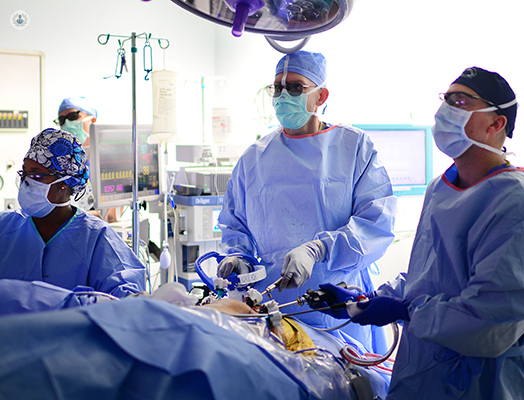Pyeloplasty
Mr Andrew Robb - Paediatric urology
Created on: 02-21-2018
Updated on: 09-05-2023
Edited by: Conor Lynch
What is a pyeloplasty?
A pyeloplasty is a surgical procedure to remove a blockage from one of the ureters (the tubes that carry urine from the kidney to the bladder). Such blockages are usually present from birth, but may also occur later in life, including in adults. The sooner the problem is dealt with, the better, and so pyeloplasty is frequently performed on infants.

Why is it done?
The human urinary system is made up of the kidneys, the ureters, and the bladder. The kidneys filter the blood, removing waste substances which need to be passed out of the body. To remove them, the kidneys create urine, which flows down through the ureters to the bladder, where it is stored until the patient goes to the toilet.
If one of the ureters is blocked, urine cannot flow easily from the kidney to the bladder, leading to hydronephrosis and the kidney becoming swollen and damaged.
What does pyeloplasty involve?
Pyeloplasty is usually performed with the patient under general anaesthetic. It tends to take between one and half and two and a half hours.
There are two types of pyeloplasty procedures:
- Open surgery – the more traditional method involves making an incision in the patient’s side, which is then closed with dissolvable stitches after the procedure.
- Keyhole (laparoscopic) surgery – a telescopic device with a light and a miniature video camera and tiny specialised instruments are inserted through tiny incisions. The abdomen is inflated using carbon dioxide so that the surgeon has space to operate via these tiny holes, without cutting the patient open. The smaller incisions heal much faster, but the procedure takes special training to perform.
The surgeon will discuss which method is most appropriate for each case.
In both techniques, the surgeon finds the site of the blockage, removes the blocked section of the ureter and reconnects the severed ends. A stent is inserted to keep the ureter open and stable during the healing process. This will need to be removed a few weeks later.
How do you prepare for pyeloplasty?
The doctor will provide instructions for how to prepare, which usually includes not eating or drinking for a certain number of hours before the procedure. The doctor should also be informed of any allergies the patient has and any medication they are currently taking.
What is recovery from a pyeloplasty like?
After pyeloplasty, it is normal for the patient to experience some discomfort, which should be manageable with paracetamol. In the days after the operation, the patient should drink plenty of water to flush out the kidneys. They should also avoid having a bath or shower for two days, and avoid having a long bath for some time after.







